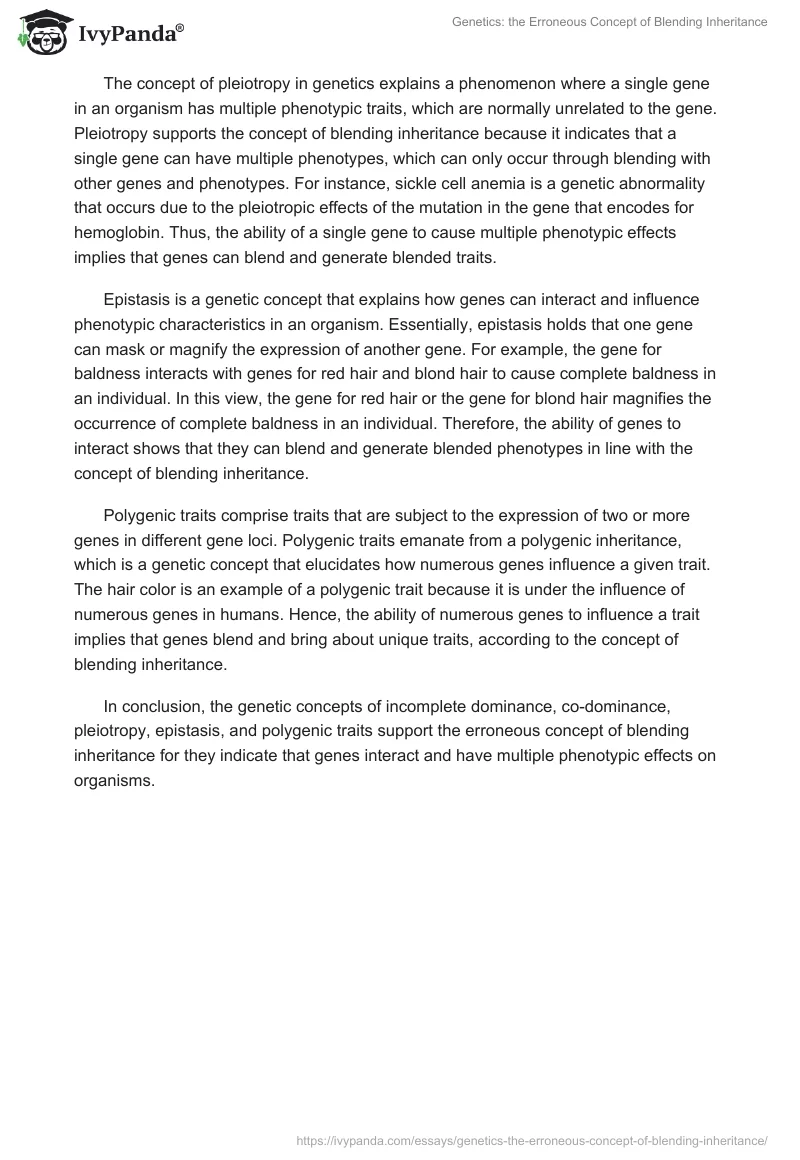Before the discovery of Mendelian genetics, Aristotle and Hippocrates supported the concept of blending inheritance in explaining how organisms inherit traits. The concept of blending inheritance holds that genetic traits of parents randomly combine and generate intermediate traits in their respective offspring. However, the emergence of Mendelian genetics has rendered the concept of blending inheritance erroneous due to its inability to explain the persistence of variations and intermittent occurrence of traits. Therefore, this essay explains why valid genetic concepts such as incomplete dominance, co-dominance, pleiotropy, epistasis, and polygenic traits support the erroneous concept of blending inheritance.
The concept of incomplete dominance in genetics explains a situation where the expression of one of a pair of alleles partially dominates or suppresses the other allele. In genetics, traits can either be dominant or recessive depending on their expression levels in organisms. In incomplete dominance, offspring acquire intermediate traits, which reflect the blend of different traits of the parents. For example, the cross between red-flowered and white-flowered pea plants results in the production of pink-flowered pea plants. Essentially, traits in red flowers partially dominate the traits in while flowers resulting in blended traits in pink flowers. In this view, incomplete dominance in genetics supports the concept of blending inheritance.
The concept of co-dominance in genetics elucidates a scenario where there is an equal expression of dominant or recessive genes resulting in the production of a combined trait. Co-dominance normally occurs when parents with dominant traits or recessive traits cross and give rise to offspring with dominant traits or recessive traits respectively. Moreover, the expression of the inherited dominant traits or recessive traits has equal strength in that neither trait can dominate the other. As dominant traits or recessive traits in organisms have equal strength of expression, they blend and confer traits that reflect both traits. For example, A and B are dominant traits of a blood group that equally blend to form the AB blood group. Thus, co-dominance supports the concept of blending inheritance in genetics.
The concept of pleiotropy in genetics explains a phenomenon where a single gene in an organism has multiple phenotypic traits, which are normally unrelated to the gene. Pleiotropy supports the concept of blending inheritance because it indicates that a single gene can have multiple phenotypes, which can only occur through blending with other genes and phenotypes. For instance, sickle cell anemia is a genetic abnormality that occurs due to the pleiotropic effects of the mutation in the gene that encodes for hemoglobin. Thus, the ability of a single gene to cause multiple phenotypic effects implies that genes can blend and generate blended traits.
Epistasis is a genetic concept that explains how genes can interact and influence phenotypic characteristics in an organism. Essentially, epistasis holds that one gene can mask or magnify the expression of another gene. For example, the gene for baldness interacts with genes for red hair and blond hair to cause complete baldness in an individual. In this view, the gene for red hair or the gene for blond hair magnifies the occurrence of complete baldness in an individual. Therefore, the ability of genes to interact shows that they can blend and generate blended phenotypes in line with the concept of blending inheritance.
Polygenic traits comprise traits that are subject to the expression of two or more genes in different gene loci. Polygenic traits emanate from a polygenic inheritance, which is a genetic concept that elucidates how numerous genes influence a given trait. The hair color is an example of a polygenic trait because it is under the influence of numerous genes in humans. Hence, the ability of numerous genes to influence a trait implies that genes blend and bring about unique traits, according to the concept of blending inheritance.
In conclusion, the genetic concepts of incomplete dominance, co-dominance, pleiotropy, epistasis, and polygenic traits support the erroneous concept of blending inheritance for they indicate that genes interact and have multiple phenotypic effects on organisms.


